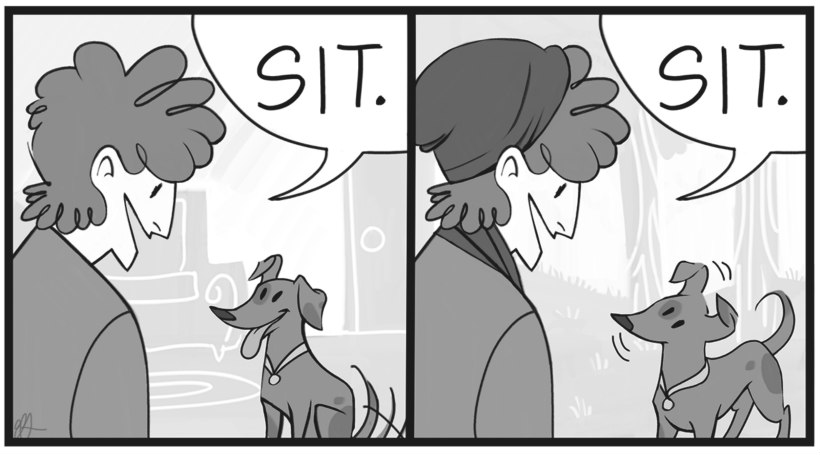[dropcap]M[/dropcap]any instructors realize the value of teaching students fundamental concepts rather than focusing on details. A certain number of basic facts may have to be memorized, but beyond that it is generally more important to have students learn how to apply those facts to solve problems. A considerable amount of research suggests that active learning is an effective way for students to understand and retain information. Accordingly, I like to illustrate a concept and then have the students work with that principle through group problem-solving, subsequently answering a series of questions to demonstrate that they understand how to apply facts to solve a particular problem. This approach appears to work reasonably well, with one significant caveat—if I make a relatively minor change in the group problem, many of the students cannot apply what they just learned. Why not? One reason is that the context is critical. Even though the problem might be similar to the one they just solved, if the context changes, students do not realize that what they have already learned still applies.
In my introductory biology course, I repeatedly see this problem on the topic of gene regulation; how specific genes are turned on and off to optimize cellular function. Teaching this concept typically involves a discussion of the “operon”. In brief, an operon refers to a group of genes that are coordinately regulated. That is, the proteins encoded by these genes all function in one common pathway. Let me explain with an analogy. Consider an assembly line at the Ford Motor Company. The plant makes cars and there are two key aspects of the assembly line that require regulation. First, there is no point in having only half of the workers show up because the assembly line only works when everyone is on the line. Second, it is wasteful to keep making cars if the supply has exceeded the demand. In the Ford plant, these problems can be dealt with by supervisors who keep track of absentee workers and production levels. To do so, these supervisors needs input, which can come from their boss, or other supervisors who oversee production of different vehicles. Maybe there are meetings during which the supervisor in charge of the Ford Focus can coordinate with the one in charge of Ford Fusion production.
So how does this work in a cell, where there is no direct equivalent of a supervisor? Essentially, each gene in the operon group is controlled by one common element—a “promoter”, which is present in front of the DNA encoding these genes. For our purposes, the promoter is equivalent to the supervisor; it determines whether the cell makes all of the necessary proteins, or none of them.
The idea of an assembly line and a supervisor is straightforward and easily understood by students. However, consider how frustrating it would be if you explained the concept using the Ford Motor Company, then asked these same students to apply these concepts to car production at the General Motors plant, and they stared at you with blank expressions. “But we have not learned how car production is controlled at GM,” they might protest.
You used the Ford Motor Company as an example; however, that is all it is meant to be. The only reason for students to learn the details of one particular system is to allow them to work through problems, enabling them to comprehend the key principles. In the case of the cell, we are concerned with the idea of coordinated gene expression. This is a common aspect of regulation that occurs repeatedly with slight variations. Therefore, I would like my students to be able to apply the concepts discussed when learning about one specific example to other aspects of gene regulation.
My approach for getting the students to learn this material is to have them first prepare for a reading quiz on the topic. Typically, certain facts and terms need to be memorized, and the students can do this on their own. For example, I can tell the students that the promoter controls the synthesis of genes, but I’d rather spend that time showing how the promoter actually responds to different signals in the cell. Going back to the car analogy, I could use our limited class time defining the meaning of “supervisor”, “office”, “telephone” and other key words, or I could ask the students to read about them. With the latter approach, I can use class time to show how the supervisor deals with various factors relevant to car production. Working through problems or case studies shows the students how to use the information they memorized in a practical way.
Thus, it is frustrating when I find that even students who do well answering questions about one operon are usually at a complete loss when I ask a very similar question about another operon. Even when the essence of the regulatory pathway is quite similar, literally changing the name is often enough to prevent the students from answering the associated questions.
So why do students have difficulty applying information from one operon to another? Believe it or not, this is where information we have learned from dog training comes into play. It turns out that not just students, but even dogs (highly trainable animals), have a difficult time generalizing because the information they have learned is put into their brains in a specific context. For example, you may have taught your dog to respond to the verbal cue “sit” when inside your home. But take the dog outside, tell her/him to sit, and your dog may look bewildered and not respond (Fig. 1). You are confused and may begin to question you dog’s intelligence. Is it because the dog is distracted? Chances are, your dog is paying attention to you, and being distracted is not the problem in this case. Most likely it’s because you were indoors when you first trained your dog to sit. To a dog, this does not necessarily have anything to do with performing the same action outdoors. You can see that it’s the same, but it’s not to your dog. As with my students, even though they see that two operons are similar they’re not functioning in the same context and that makes them think they don’t know what’s going on.
Having identified this key problem in being able to generalize from one specific context to another, the question is whether there is a solution. According to Bloom’s taxonomy (Anderson, et al., 2001; Bloom, et al., 1956), being able to apply the information from the original example to the revised version would require the following (new domain/original domain): 1) Remembering/knowledge; 2) understanding/comprehension; and 3) applying/application. In other words, my students would first need to be able to remember the basic factual information. Second, they would need to understand how to apply the information to the specific problem they are studying. Finally, they would have to apply the concepts they learned to a new situation.
The active learning format that I use (Klionsky, 2004) can be easily applied to any course. The first aspect involves a reading quiz at the start of each session (Klionsky, 2008). The use of this quiz ensures that students do the assigned reading and memorize a small number of facts, without my having to introduce these facts through a lecture. This approach saves time, which I use for group problem-solving. The latter forces the students to actually use the information they learned, thus moving beyond memorization. Participation in the problem-solving is enforced through the administration of a concept quiz. The entire course grade is based on these daily quizzes. With this approach, I have focused on the first two aspects of learning, without necessarily considering the third component. That is, I have concentrated on helping the students learn the concepts rather than just memorize the facts, but now I have realized that I need to add another level: I have got to teach them how to solve a problem when the context changes.
I think most instructors would agree that we want to provide our students with the skills to apply their knowledge to a future situation, whether it be in the classroom or in a research or job setting. So how do we enable students to see beyond the immediate facts and specific problems? I have three suggestions: First, I try to emphasize to them that the details are not as important as understanding the principle. Second, whenever possible I present a second example, usually in less detail, that illustrates the same principle, so they can see that it applies to more than one situation. Third, I try to demonstrate the relevance of the topic in a different context (Klionsky, 2017). As mentioned here, the need for coordinated gene expression, a general concept, can be seen by comparison with an assembly line, an example that’s familiar to students. Along these lines, this is a very fundamental concept that pertains to various pathways, both in the cell and in the real world.
The critical point is that we need to emphasize that we want our students to view memorization of the facts as only the first step in the learning process. Even the application of those facts, while an improvement over memorization by itself, is not enough. We need to go to at least the next step and show them how to use the scientific method to begin to answer problems that may not have answers already written in the textbook.
The extension to context is not necessarily a difficult one, but it needs to be directly demonstrated to students.

Figure 1. It is important to consider context when trying to teach general concepts. Illustration by Elise N. Griswold.
Even though you may have successfully taught your dog to sit indoors, that does not mean it has learned to respond to the same command in a different context, such as when you are outdoors. Similarly, just because a student has mastered one operon does not automatically mean that he/she can apply the same problem-solving skills to a similar type of gene regulation.
References:
Anderson, L.W., D.R. Krathwohl, P.W. Airasian, K.A. Cruikshank, R.E. Mayer, P.R. Pintrich, J. Raths, and M.C. Wittrock (2001). A Taxonomy for Learning, Teaching, and Assessing: A revision of Bloom's Taxonomy of Educational Objectives, (New York: Pearson, Allyn & Bacon).
Bloom BS, Engelhart MD, Furst EJ, Hill WH, Krathwohl DR. Taxonomy of Educational Objectives, Handbook I: The Cognitive Domain. New York: David McKay Co Inc., 1956.
Klionsky, D.J. 2004. Talking biology: Learning outside the book—and the lecture.
CBE – Life Sciences Education, 3: 204-211.
Klionsky, D.J. 2008. The quiz factor.
CBE – Life Sciences Education 7: 265-266.
Klionsky D.J. Does relevancy matter?
Biochemistry and Molecular Biology Education, 2017; 45:377-8.
Daniel J. Klionsky is a research professor at the University of Michigan’s Life Sciences Institute and the Alexander G. Ruthven Professor of Life Sciences, Department of Molecular, Cellular and Developmental Biology, U-M College of Literature, Science, and the Arts. Address correspondence to: klionsky@umich.edu. The author thanks Dr. Brittany Albaugh (Eastern Michigan University) and Dr. Maryellen Weimer (Penn State University) for their helpful comments.







